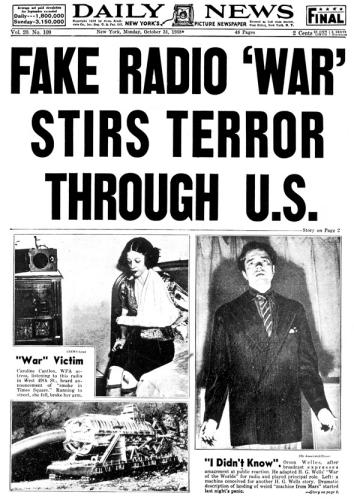
Photo by Carl Van Vechten/Library of Congress via Wikimedia Commons
Wednesday marks the 75th anniversary of Orson Welles’ electrifying War of the Worlds broadcast, in which the Mercury Theatre on the Air enacted a Martian invasion of Earth. “Upwards of a million people, [were] convinced, if only briefly, that the United States was being laid waste by alien invaders,” narrator Oliver Platt informs us in the new PBS documentary commemorating the program. The panic inspired by Welles made War of the Worlds perhaps the most notorious event in American broadcast history.
That’s the story you already know—it’s the narrative widely reprinted in academic textbooks and popular histories. With actors dramatizing the reaction of frightened audience members (based on contemporaneous letters), the new documentary, part of PBS’s American Experience series, reinforces the notion that naïve Americans were terrorized by their radios back in 1938. So did this weekend’s episode of NPR’s Radiolab, which opened with the assertion that on Oct. 30, 1938, “The United States experienced a kind of mass hysteria that we’ve never seen before.”
There’s only one problem: The supposed panic was so tiny as to be practically immeasurable on the night of the broadcast. Despite repeated assertions to the contrary in the PBS and NPR programs, almost nobody was fooled by Welles’ broadcast.
How did the story of panicked listeners begin? Blame America’s newspapers. Radio had siphoned off advertising revenue from print during the Depression, badly damaging the newspaper industry. So the papers seized the opportunity presented by Welles’ program to discredit radio as a source of news. The newspaper industry sensationalized the panic to prove to advertisers, and regulators, that radio management was irresponsible and not to be trusted. In an editorial titled “Terror by Radio,” the New York Times reproached “radio officials” for approving the interweaving of “blood-curdling fiction” with news flashes “offered in exactly the manner that real news would have been given.” Warned Editor and Publisher, the newspaper industry’s trade journal, “The nation as a whole continues to face the danger of incomplete, misunderstood news over a medium which has yet to prove ... that it is competent to perform the news job.”
The contrast between how newspaper journalists experienced the supposed panic, and what they reported, could be stark. In 1954, Ben Gross, the New York Daily News’ radio editor, published a memoir in which he recalled the streets of Manhattan being deserted as his taxi sped to CBS headquarters just as War of the Worlds was ending. Yet that observation failed to stop the Daily News from splashing the panic story across this legendary cover a few hours later.

Photo by New York Daily News Archive via Getty Images
From these initial newspaper items on Oct. 31, 1938, the apocryphal apocalypse only grew in the retelling. A curious (but predictable) phenomenon occurred: As the show receded in time and became more infamous, more and more people claimed to have heard it. As weeks, months, and years passed, the audience’s size swelled to such an extent that you might actually believe most of America was tuned to CBS that night. But that was hardly the case.
Far fewer people heard the broadcast—and fewer still panicked—than most people believe today. How do we know? The night the program aired, the C.E. Hooper ratings service telephoned 5,000 households for its national ratings survey. “To what program are you listening?” the service asked respondents. Only 2 percent answered a radio “play” or “the Orson Welles program,” or something similar indicating CBS. None said a “news broadcast,” according to a summary published in Broadcasting. In other words, 98 percent of those surveyed were listening to something else, or nothing at all, on Oct. 30, 1938. This miniscule rating is not surprising. Welles’ program was scheduled against one of the most popular national programs at the time—ventriloquist Edgar Bergen’s Chase and Sanborn Hour, a comedy-variety show.
The new PBS documentary allows that, “of the tens of millions of Americans listening to their radios that Sunday evening, few were tuned to the War of the Worlds” when it began, due to Bergen’s popularity. But the documentary’s script goes on to claim that “millions of listeners began twirling the dial” when the opening comedy routine on the Chase and Sanborn Hour gave way to a musical interlude. “Just at that moment thousands, hundreds, we don't how many listeners, started to dial-surf, where they landed on the Mercury Theatre on the Air,” explained Radiolab this weekend. No scholar, however, has ever isolated or extrapolated an actual number of dial twirlers. The data collected was simply not specific enough for us to know how many listeners might have switched over to Welles—just as we can’t estimate how many people turned their radios off, or switched from Mercury Theatre on the Air over to NBC’s Chase and Sanborn Hour either. (Radiolab played the Chase and Sanborn Hour’s musical interlude for its audience, as if the song itself constituted evidence that people of course switched to Welles’ broadcast.)
Both American Experience and Radiolab also omit the salient fact that several important CBS affiliates (including Boston’s WEEI) pre-empted Welles’ broadcast in favor of local commercial programming, further shrinking its audience. CBS commissioned a nationwide survey the day after the broadcast, and network executives were relieved to discover just how few people actually tuned in. “In the first place, most people didn’t hear it,” CBS’s Frank Stanton recalled later. “But those who did hear it, looked at it is as a prank and accepted it that way.”
Source: http://www.slate.com/articles/arts/history/2013/10/orson_welles_war_of_the_worlds_panic_myth_the_infamous_radio_broadcast_did.html
Tags: Walking Dead Season 4 Dumb and Dumber 2 Niall Horan taylor swift Dick Van Dyke
No comments:
Post a Comment
Note: Only a member of this blog may post a comment.